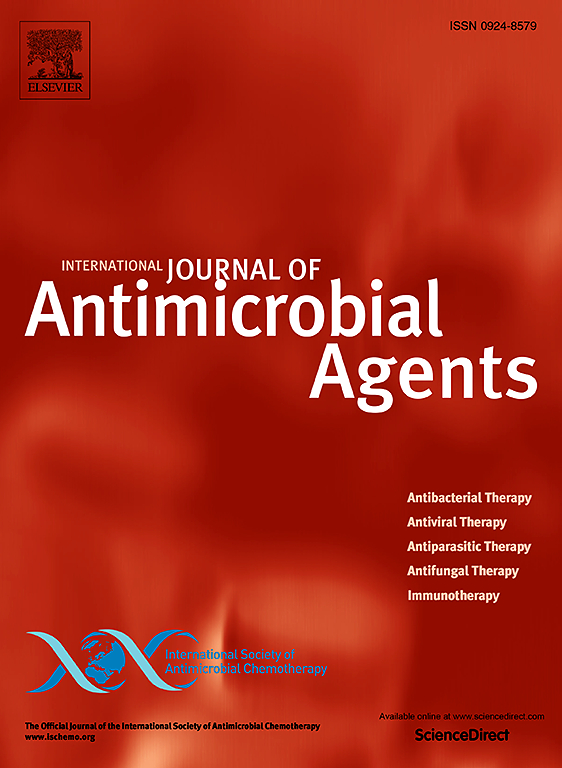葡萄牙肺炎克雷伯菌的全基因组分析和纵向研究:追踪碳青霉烯耐药性的进化和传播。
IF 4.6
2区 医学
Q1 INFECTIOUS DISEASES
International Journal of Antimicrobial Agents
Pub Date : 2025-07-30
DOI:10.1016/j.ijantimicag.2025.107583
引用次数: 0
摘要
背景:耐碳青霉烯肺炎克雷伯菌(CRKP)在葡萄牙发病率高,引起严重且经常致命的感染。目的:描述葡萄牙近40年来CRKP的进化历史和流行病学特征。方法:采用Illumina平台下进行WGS。随后进行了多位点序列分型、表面抗原鉴定和抗性基因检测。使用Roary进行核心和泛基因组分析。基因组簇(GCs)基于21个snp阈值进行鉴定。为了估计数据集中最普遍的序列类型(ST)的发散时间,使用BEAST进行贝叶斯进化分析。结果:共鉴定出19个含碳青霉烯酶的gc。blaKPC-3基因是最普遍的碳青霉烯酶,与医院和社区环境中流行的菌株有关,具有区域、区域间和国际水平的传播模式。ST15是葡萄牙最确定的序列类型,在临床和环境样本中鉴定出9种不同的GCs。在2010年代末,ST147和ST13是与blaKPC-3相关的重大暴发的罪魁祸首。结论:本研究强调了基于基因组学的监测在了解高风险克隆的进化以及AMR决定因素的传播方面的价值。获得的数据强调了全国范围内ST优势的转变,从与ESBL传播密切相关的st15主导时期,到ST147和ST13 CRKP克隆的出现,后者与国际传播有关。这项工作进一步强调了跨境监测工作的重要性,以监测CRKP毒株的出现和传播,并为风险评估和预防提供信息。本文章由计算机程序翻译,如有差异,请以英文原文为准。
Genome-wide analysis and longitudinal study of Klebsiella pneumoniae in Portugal: Tracing the evolution and spread of carbapenem resistance
Background
Carbapenem-resistant Klebsiella pneumoniae (CRKP) has high incidence in Portugal, causing severe and often fatal infections.
Objectives
Characterize the evolutionary history and epidemiology of CRKP in Portugal over a 40-year period.
Methods
WGS was performed using the Illumina platform. In silico multilocus sequence typing, surface antigen characterization, and resistance gene detection were subsequently carried out. Core and pan-genome analyses were conducted using Roary. Genomic clusters (GCs) were identified based on a 21-SNP threshold. To estimate the divergence times of the most prevalent sequence types (ST) in the dataset, Bayesian evolutionary analysis was performed using BEAST.
Results
Nineteen GCs harboring carbapenemases were identified. The blaKPC-3 gene was the most prevalent carbapenemase, linked to strains circulating in both hospital and community settings, with dissemination patterns at regional, interregional, and international levels. ST15 was the most established sequence type in Portugal, with nine distinct GCs identified in both clinical and environmental samples. Towards the end of 2010s, ST147 and ST13 were responsible for significant outbreaks associated with blaKPC-3.
Conclusions
This study underscores the value of genomic-based surveillance in understanding the evolution of high-risk clones coupled with the spread of AMR determinants. The data obtained highlights a shift in ST predominance across the country from an ST15-dominated period and strongly associated with ESBL dissemination, to the emergence of ST147 and ST13 CRKP clones, the latter associated with international transmission. This work further stresses the importance of cross-border surveillance efforts to monitor the emergence and dissemination of CRKP strains and inform risk assessment and prevention.
求助全文
通过发布文献求助,成功后即可免费获取论文全文。
去求助
来源期刊
CiteScore
21.60
自引率
0.90%
发文量
176
审稿时长
36 days
期刊介绍:
The International Journal of Antimicrobial Agents is a peer-reviewed publication offering comprehensive and current reference information on the physical, pharmacological, in vitro, and clinical properties of individual antimicrobial agents, covering antiviral, antiparasitic, antibacterial, and antifungal agents. The journal not only communicates new trends and developments through authoritative review articles but also addresses the critical issue of antimicrobial resistance, both in hospital and community settings. Published content includes solicited reviews by leading experts and high-quality original research papers in the specified fields.

 求助内容:
求助内容: 应助结果提醒方式:
应助结果提醒方式:


